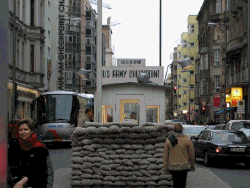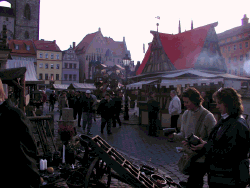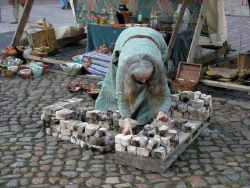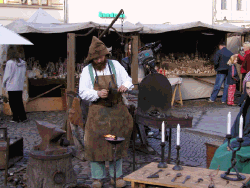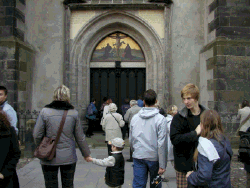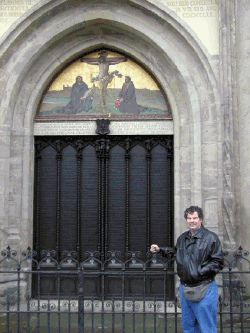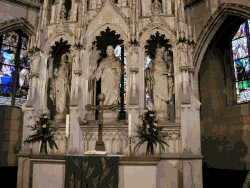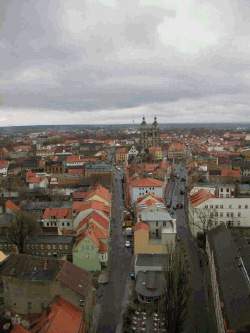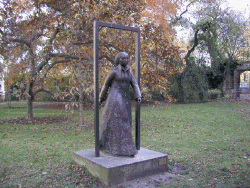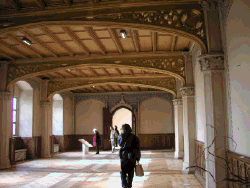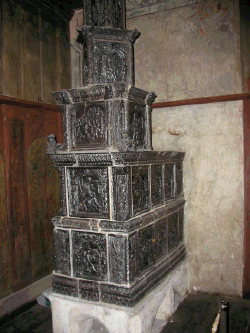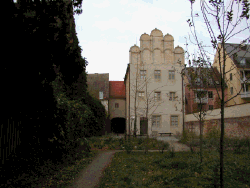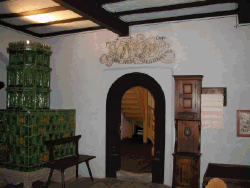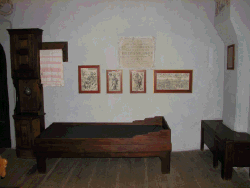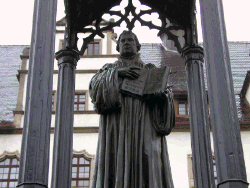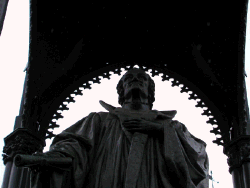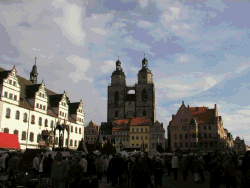Wittenberg 2002
This essay is more a travelogue than history, and more history than theology. But there is some history and some theology just the same. Caveat lector!
Note:The many pictures below are thumbnails of the original. Please wait for the page to load. You can click the pictures for a larger picture.
Introduction
On 1 July 2002, my sabbatical year began. As I write this, I am looking out a large window in my apartment in Münster, Germany, on the third floor (though in Germany they call it the second floor) of the Humboldt Haus on Hüfferstrasse. Humboldt Haus is a residence for visiting scholars.
This sabbatical has been dedicated to New Testament textual criticism, the science of determining the wording of the original documents. This discipline is needed because we no longer possess the originals of any New Testament book, and because there are hundreds of thousands of differences among the extant manuscripts (MSS). Only by a careful sifting of the data, and a rigorous comparison of MSS, can one increase in certainty as to what the original text said. And, of course, for evangelical Christians, textual criticism is of extreme importance because we are, above all, a people of the Book. But we cannot know what it means or how to apply it unless we first know what it says.
My sabbatical year has already been quite thrilling. I have spent several weeks in Greece, including a week on the island of Patmos, where John wrote the book of Revelation. The Monastery of St. John the Theologian sits atop the island, looking quite imposing from any direction. This monastery-fortress is a millennium old, with walls fifty feet high in places! And the library of this ancient monastery is absolutely stunning. I spent some time in the library examining some of the Greek New Testament MSS there. Perhaps I will tell more of my experience on Patmos at a later date.
After Greece, I took a two-week breather back home, only to head out for Egypt at the end of August. The journey was a nine-day trip to Mt. Sinai, to St. Catherine’s Monastery. I had been planning this trip for three years, negotiating with the monastery by corresponding in modern Greek. Father Nicholas Katinas of the Holy Trinity Orthodox Church in Dallas joined me, as did Dr. Timothy Ralston of Dallas Seminary. We spent a week looking at some of the “New Finds” manuscripts. These are manuscripts that were discovered in 1975 when a fire broke out at St. George’s Tower, revealing a hidden compartment. In the compartment were 1200 manuscripts and 50,000 fragments (all undamaged by the fire). Among the 1200 manuscripts are over 200 biblical manuscripts. Most exciting among the discoveries were leaves of Codex Sinaiticus, the fourth-century MS that Tischendorf carried off to Russia in 1844 and 1859. Sinaiticus contains the oldest complete Greek New Testament in existence—by 500 years! It now resides in the British Library in London. That’s another story. There are also over a dozen uncial MSS of the New Testament (uncial MSS are capital-letter MSS on parchment; all of them are dated no later than the tenth century and as early as the third century, making them quite valuable for determining the wording of the original). We were so privileged to spend a week in the library handling and examining these ancient treasures! But that report will have to wait for a later time as well.
I took one week off after Egypt, packed my bags and headed out for Münster, Germany. My wife, Pati, joined me for this trip (as she had for Greece). Why Münster? On the western edge of the old city is the Institut für neutestamentliche Textforschung, or the Institute for New Testament Textual Research. Founded in 1959 by Dr. Kurt Aland, this not-terribly-large four-story building houses microfilms and photographs of virtually all Greek New Testament manuscripts known to exist. A few decades ago, Dr. Eldon Epp noted that there are probably more textual critics at this institute than there are in the rest of the world. That situation has changed to some degree, but Münster is still the epicenter for New Testament textual studies. I am here working, in part, on exhaustive collations of MSS of Paul’s letters. Every variant is noted for each MS that is examined. By doing this kind of work, one can determine, to some degree, what a particular scribe’s tendencies were. For example, if one MS tends to have “Christ” where other MSS have “Lord,” its voice is discounted in places where other MSS join it in reading “Christ.” But if that same MS has “Lord” in disputed places, its voice is weighed more heavily. This kind of painstaking work has hardly been done on New Testament MSS, in large measure because there are very few who are both skilled in the task and have access to the photographs. On top of that, it is quite tedious work (especially because the microfilms are not easy to read, being cheap-grade photographs).
We’ve been here now for seven weeks. Pati and I are thoroughly enjoying our time in Germany. But we wanted to take a break and we decided to go to Wittenberg last week. We were there for four days, along with my assistant, Presian Smyers, who is helping me in the collation work on Paul’s letters.
The Autobahn
We rented a car since our only transportation to date has been two tired legs (per person) and one used bicycle each. We got out on the famous German Autobahn on the morning of 29 October, taking the A2 east to Berlin. It was my first time to drive in Germany; I wasn’t sure what to expect. Altogether we drove almost 1000 miles (nearly 1600 kilometers) in the six days that we had the car. I asked Pati to rate driving in America, Greece, and Germany in terms of how pleasant the experience was. Germany ranked by far the highest; Greece came in a rather distant third. The people in Germany are polite, respectful, and more patient than Americans. But, boy, do they drive fast! As is well known, the Autobahn has long sections of no speed limit. (But in many places the speed is limited to 120 kilometers or less.) We found ourselves going 160 to 180 kilometers for a good bit of the trip. It sure was fun! And we did not experience road rage except once (from someone who was obviously not German).
Berlin
Our first stop was Berlin. We spent two days and one night there, hardly enough to take in much. The museums in Berlin are world-class, and the cafs are wunderbar. Unfortunately, many Americans have an image of Berlin that belongs to an era long gone.
Presian and I went to the Staatsmuseen (national museum) to look at MSS, while Pati went shopping. We had the opportunity to examine two ancient uncial MSS, but no more since the MSS had been temporarily moved. After the MS discovery tour, we went to Checkpoint Charlie, the place where East Berlin met West Berlin. It was an eerie feeling. The Berlin Wall had been constructed in August 1961; it kept East Berliners from getting into the west. Some people, however, had to cross the lines in either direction. Checkpoint Charlie was the principal place where this occurred. Of course, we are all familiar with the many stories of tragedy and triumph, of the hundreds of people who did escape from East Berlin and made it to freedom (or who died trying). Many of these folks got out through Checkpoint Charlie by stealth, hiding in ingenious compartments. One of the most successful stories was of a Volkswagen Beetle that had the compartment below its trunk hollowed out so that people could hide there. Several folks escaped from the tyranny of Communism in this manner. The VW “bug,” along with hundreds of other artifacts from the Cold War, was on display at the museum next to Checkpoint Charlie (known as “Der Haus am Checkpoint Charlie”). I marvel at what lengths people will go, what incredible risks they will take, for the sake of freedom.
Checkpoint Charlie in Berlin
On 10 November 1989, East Berlin was officially open. Shortly after that, the wall was torn down. East Berliners (and East Germans) were free at last! The date is significant, though not intentional: November 10 is Martin Luther’s birthday. East Germany was freed 506 years to the day after Martin Luther was born.
Wittenberg
Reformation Eve
We left Berlin on the evening of 30 October, driving the 100 or so kilometers south to Wittenberg. We had reserved a hotel room at the L & K Pension, about two kilometers from the town square. We made our reservations through the city’s website (http://www.wittenberg.de/), just a couple of weeks earlier. I was surprised at how easy it was to reserve a room there, especially since we were going to be staying through the end of the month (and, therefore, over Reformation Day). I thought, in light of the fact that we could get two rooms in the same very small hotel (one for Pati and me, and one for Presian), that perhaps the celebrations would be minimal, that few visitors would come to town on this historic day. I am so glad that I was wrong! Wittenberg had thousands of visitors on Reformation Day, and the town was ready for it. I found out that only the private hotels off the beaten path (known as pensions) were not full. We had chosen a pension because of price, not realizing that this would be the only way we could get a room in Wittenberg. The L & K was very pleasant, with a surprisingly large room for two. It is a new building a block from the new Stadthalle (city hall). With real parking places and a decent breakfast, the $45 a night for two was a great bargain. I recommend this pension to you. But be warned: they only take cash. And if you arrive after 8 p.m. (like we did), no one will be there to greet you. The room key will be tucked away in some hidden place (they will tell you about this one or two days before your arrival; make sure to access email before you arrive). Finally, like so much of what used to be East Germany, they don’t speak English at the L & K. Come with a dictionary and some patience. And perhaps pick up a few German phrases before you go.
After we deposited our bags in the room, we drove down to the main drag. Quite a bit of Wittenberg is still intact as it was in medieval times. But there are newer buildings next to older ones, and buildings in ruins from neglect. World War II was not the cause: only two bombs dropped on the whole city. It looked to be more recent than that. Indeed, during the Cold War, Wittenberg was under Communist rule. This city, whose name means “white mountain” (so named for the sand found in the region, perhaps from the Elbe River which Wittenberg touches), ironically has factories on the edge of town with smokestacks, billowing with white smoke day and night. This ugly sight has become the new ‘white mountain’ of Wittenberg. But the industry of the Communist era is being replaced, once again, by tourism. Yet even eleven years after the east collapsed, there are still only 120,000 visitors annually to the epicenter of the Protestant Reformation. (And half of them, it seemed, showed up on Reformation Day!)
In the two streets that constitute the downtown area proper almost everything is well preserved. After we parked the car, we went to one of the newer restaurants in town, the Schlossfreiheit, built in 1683, 200 years after Luther’s birth. In this cozy little restaurant, we enjoyed a fabulous meal at a very reasonable price. On the menu was “Luther Bier,” a dark beer that was allegedly similar to the kind that Luther enjoyed. The more I learn about this great saint, the more I like! I picked up a postcard that had a saying of Luther’s (although I don’t know the source; perhaps Table Talk?): “Wer viel Bier trinkt, schlft gut. Wer gut schlft, sündigt nicht. Und wer nicht sündigt, kommt in den Himmel!” (The one who drinks much beer sleeps well. He who sleeps does not sin. And he who does not sin goes to heaven!”) One of the things about Luther that I love so much is that he was not pretentious; he was down to earth. He belonged to that rare breed known as ‘guy-next-door Reformer.’
Even after 10 p.m. there was quite a bit of activity near the Schlosskirche (Castle Church), the church on whose main door Luther put up his 95 theses. The door was open, but a guard in medieval dress was posted. And, curiously, the people milling around the church were teenagers. Hundreds of them. We found out later that annually scores of youth come to Wittenberg as confirmands in the Lutheran church. This year over 700 youth were there. They were allowed inside to spend the night in this historic church. We were excited about what the next day would reveal.
Reformation Day
We woke the next morning, 31 October, in anticipation of seeing some of Christianity’s most important sites. After a solid German breakfast, we headed out for the town square. As we drove, I began to reflect on the historic occasion. Five hundred years ago, the University of Wittenberg was founded. Within ten years, a bright young monk named Martin Luther joined its faculty. His doctorate was conferred in the Schlosskirche in October 1512. And 485 years ago on this day (31 October 1517) Luther marched two kilometers down the street from the monastery where he lived to the Schlosskirche and nailed his 95 Theses to the large double wooden door. (It was the custom of the day to post announcements on the church door.) He titled the flyer “Disputation of Dr. Martin Luther on the Power and Efficacy of Indulgences.” In this post, he asked for a public debate: “Out of love for the truth and the desire to bring it to light, the following propositions will be discussed at Wittenberg, under the presidency of the Reverend Father Martin Luther, Master of Arts and of Sacred Theology, and Lecturer in Ordinary on the same at that place. Therefore, he requests that those who are unable to be present and debate orally with us, may do so by letter.”
That debate never came. Shortly after Luther posted his theses, someone tore down the sheet, and copies of it soon got to printers throughout Europe. Within weeks, over 100,000 copies of Luther’s manifesto had been printed. The Reformation was born!
To be sure, certain parts of the famous 95 Theses were worded quite strongly. But other parts were in praise of the pope and his policies, and appeared to be no more than a plea from a Catholic monk for a little sanity and sanctification in the matter of indulgences. Altogether, the 95 Theses do not yet show the clear reasoning about justification by faith alone that Luther would be known for. But they opened Pandora’s Box, and were a public display of incredible bravado in the face of a politico-religious authority that ruled all of life. It was Luther’s heart and head that started the Reformation. One without the other would not have done the job.
We parked the car and walked to the town square. As we turned the corner and saw the square we were immediately transported back half a millennium. The sights, smells, and sounds were all medieval. The city has done a lovely job of preserving this heritage, and the town square is the right place to have it, since that is a well-preserved medieval site as well.
Town Square with Pati and Presian in foreground, kiddie ferris wheel in background
Woman constructing brick oven for day’s festivities
Medieval Wittenberg on TV!
Making our way through the crowds, we got down to the Schlosskirche. This church was built in 1490. It was thus virtually new in Luther’s day. The large double-wooden door where Luther nailed his 95 Theses, the most famous door in Europe (known as the Thesentür), has long since disappeared. It was replaced in 1858 by a double brass door with Luther’s theses written on it. Using my sanctified imagination, I thought about the events that transpired 485 years ago this day. Luther most likely came from the monastery or the university (next door to the monastery), made his way down the long Collegienstrasse (almost two kilometers from the monastery to the Schlosskirche), with hammer and theses in hand. He was fed up with the practice of indulgences that, in essence, excused only the wealthy from purgatory and turned paupers into everyone whose hopes for the afterlife made their existence on earth miserable.
In a little antique bookstore on Collegienstrasse, I saw a painting that captured well the feeling of that day. (Unfortunately, the painting was not for sale.) It was of a young monk walking away from the door of the Wittenberg church, with hammer in hand, looking determined, ready for a battle. A number of townsfolk were standing around, pointing and gawking at what he had just posted. There was obviously an air of excitement. Off to the corner was another monk, but with a rather dour look on his face: trouble was brewing, and Luther was the brewmeister! This monk was obviously opposed to Luther and he knew well what the implications of Luther’s act meant. Of course, this painting is a bit romanticized: the theses were in Latin and most of the townsfolk probably did not understand their meaning. Within weeks, however, the 95 theses had been translated into German.
Schlosskirche Door, with mural above showing Luther and Melanchthon worshiping at the foot of the cross
Here I am in front of the Thesentür, with much the same expression that Luther probably had when he posted it.
The tower of the church overlooks all of Wittenberg, rising to 88 meters high at the top of the spire. On Saturday, 2 November, I took the 287 or so steps up to the top where I could see the sites. I was quite surprised at the beauty and majesty of this famous church. I expected it to be a little parish church, but it was truly magnificent. Wrapping around the tower today are the first few words, in German of course, of Luther’s most famous hymn, “A Mighty Fortress.” It may well be that the tower was the inspiration for Luther’s hymn, although its present form was not completed until the late 1800s.
The altar in the Schlosskirche
View of town from tower
This is a view of the town of Wittenberg from the tower of the Schlosskirche. Both main roads lead to the Schlosskirche; its tower can be seen plainly anywhere along these roads. The twin-towered church in the background is the Stadtkirche where Luther regularly preached; in front of it is the town center. The last building on the right whose outline is visible [just beyond the orange-tiled roof of the university] is Lutherhalle, the Augustinian monastery where Luther made his home.
After the visit to the Schlosskirche, we traveled up Collegienstrasse to the opposite end, to Luther’s home. If you are expecting a small, quaint one-story medieval brick home, you are in for a surprise! Luther lived in the Augustinian monastery, a rather large complex right next to the university. Within seven years of the beginning of the Reformation, the monastery was dissolved. Eight years later, in 1532, the building was granted to Luther by the elector of Saxony. Lutherhalle became his home for the rest of his days. He and his wife, the former nun, Katharina von Bora (sixteen years his junior), made a home here starting in 1525. They had six children, four of whom reached adulthood. But Luther and Kthe (or “Katie,” as he affectionately called her) did not occupy the entire Lutherhalle. They lived in a small portion of the former monastery, leased out several rooms to students, and allowed some rooms, including the large auditorium, to be used as classrooms.
Lutherhalle boasts the largest collection of Reformation art and artifacts in the world. Unfortunately, when we were there, the building was undergoing renovation and a little archeological spadework. Virtually all of the artifacts had been removed. The outside of the building was completely covered with tarps. But Luther’s Stube or heated room (with a large oven) where he studied and ate with his students (and where the conversations in his famous Table Talk took place) was still furnished to some degree. (It was unfortunately so crowded that I could not get very good pictures of it; but below is one of the oven.) The building was open only for a couple hours on Reformation Day; we made sure to visit it.
Katie on the go! (Statue of Katie von Bora in the courtyard of Lutherhalle.) I have a wife like that, too
The auditorium in Lutherhalle where lectures to as many as 400 students were delivered.
The oven in the Stube where Luther ate with his students, studied, and presumably had his ‘tower experience’.
Just a few doors down the street is Melanchthon’s home. Philipp Melanchthon was Luther’s right-hand man, coming to the university in 1521. Born Philipp Schwarzerdt (“dark earth”), his name was changed by his great-uncle, the famous classical scholar Johannes Reuchlin, to its Greek equivalent, Μελάνχθων. Melanchthon had earned his bachelor’s degree by age 14 (1511) at the University of Heidelberg, his master’s degree at Tübingen before the age of 17 (1514). He was extremely intelligent, and especially gifted in Greek, Hebrew, and Latin. At first, his career was in ancient Greek, but after he met Luther he became interested in theology. The mind of Melanchthon and the heart of Luther were a powerful combination! In a large measure, Melanchthon was the brains behind the initial stages of the Reformation. He penned the great Augsburg Confession of 1530, the first official Protestant articles of faith. The statement on justification is worthy of mention: “They [the church] also teach that people cannot be justified before God by their own strength, merits, or works, but are freely justified for Christ’s sake, through faith, when they believe that they are received into favor, and that their sins are forgiven for Christ’s sake, who, by his death, has made satisfaction for our sins. This faith God imputes for righteousness in his sight. Rom. 3 and 4.”
Melanchthon was a popular professor. He sometimes filled his lecture hall with 200 students to teach them Greek! Melanchthon also wrote the first ‘modern’ Greek grammar (as well as a Latin grammar), an introductory text to enable students to grasp the language. His battle cry, ad fontes (“back to the sources!”), became the battle cry of the Reformation. His desire was to strip away fifteen centuries of tradition and get back to what the New Testament teachings were all about. To do this, he had to get behind the Latin Vulgate, behind the church fathers, behind the papacy and ecclesiastical layers, to the Greek New Testament itself. The Greek New Testament is indeed the source of truth. Melanchthon was on the right track.
Melanchthon’s home was built for him in 1539 by Johann Friedrich, the Elector of Saxony, after Melanchthon had received offers from several other universities in Europe. As the “teacher of Germany,” Melanchthon was a national treasure. Wittenberg had to do all it could to keep him at their university. It is a four-story, narrow building on Collegienstrasse, significantly larger than the tiny home he and his family had been used to up till 1539.
Melanchthon’s house from the herb garden
Melanchthon’s Stube—a study, dining room, and living room
Melanchthon lived, studied, ate, fellowshipped with friends and students, and died in this Stube
After a delicious dinner at the Schwarz Br Kartoffelhaus (“Black Bear Potato House”) on the main drag, we retired for the evening. This restaurant dates back to the time of Luther; they claim that it was one of Luther’s favorites.
We were exhausted from scurrying back and forth all day, taking in sites, pondering the significance of a lone brave act by an Augustinian monk so many years ago. That act set the world on fire! It was a gutsy move to challenge the corruption of the church, and it began to unravel the western world’s view of authority that it had held for many centuries, one based on tradition. Luther argued that revelation was a higher authority than tradition. People jumped on the Lutheran bandwagon for their own reasons, not all of them noble and pure. Many joined Luther because it gave them a political or financial advantage; some joined him because they embraced the truth of his convictions as their own. Who then could have imagined that Protestantism would become the third great branch of Christianity (after Roman Catholicism and Orthodoxy), and would in fact outgrow the other two put together?
A Day Trip to Dresden
To a large degree, the discipline of textual criticism is an application of Melanchthon’s motto, ad fontes. For in this discipline, we are trying to recover the original text of the New Testament by examining the most ancient documents we can find. I thought about Melanchthon and his passion for truth when I took a side trip to Dresden on Friday, 1 November. I visited the university library to examine the famous Codex Boernerianus, the ninth-century Greek-Latin diglot of Paul’s letters (Gregory-Aland 012, a.k.a. Codex Gp. This is now housed in the brand new (finished in October 2002) university library (Staats Universittsbibliothek). The manuscript librarian, Dr. Thomas Haffner, was extremely helpful. What a joy it was to look at this ancient MS! I had seen the “pseudofacsimile” before, a reproduction of the text done in 1909, but never the real thing. Inside the cover of the book was a sign-up sheet covering a period of 96 years (1901—1996). During that time only 21 people had examined the MS (all but one with German names). The longest gap was from 1970 to 1992, followed by one from 1936 to 1948, mute testimonies to the ravages of malevolent political regimes.
There are several pages on this MS that are virtually unreadable, and a few where the scribe had scraped clean his parchment, leaving nothing in its place. To date, those blank places have not been able to be read. But there is a new technology that can recover the text that used to be there. Known as multi-spectral technology (MSI), it has been used successfully by Dr. Greg Bearman (a professor at CalTech) on the Genesis Apocryphon to decipher 200 words that were completely unrecoverable by any other means. Dr. David Armstrong, a classics professor at the University of Texas has also used it to read some of the charred remains of the Herculaneum papyri. This technology is opening doors that have been long closed. There are over 100 Greek New Testament MSS that have been scraped and reused for different purposes. Known as palimpsests, these MSS have an undertext that is often undecipherable. But with MSI, that undertext will be able to be read. How exciting it is to live at a time when new discoveries will be made because of new technology! (It is almost incredible to think about: we know that discoveries will be made, we know how to make them, and we even have the MSS. All that is required is permission from the libraries and monasteries that possess these ancient treasures.) A few years ago, a famous textual critic declared that no new discoveries were left to be made in this field. However, not only are there hundreds of yet-to-be discovered MSS, hiding in the recesses of ancient monasteries, but there are also a good number of known MSS whose texts have not been completely legible... until now. Not only palimpsests, but also papyri, water-damaged MSS, and many other hard-to-read MSS can benefit from MSI. If you’ve read this far, your interest in the scriptures is no trivial thing. I ask you to consider praying for libraries and monasteries to open their doors to qualified individuals who can take MSI photographs, finally giving the world the words of these precious texts that have been hidden from us for so long! The promise of this new technology is one of the reasons I founded the Center for the Study of New Testament Manuscripts this year (CSNTM). It became incorporated on 13 September 2002. If you’d like to find out more about the Center, simply visit the website, www.csntm.org, or write to me directly.
Besides Codex G, I also wanted to examine some of Dresden’s other Greek New Testament MSS. I was grieved to learn that four of the university’s Greek New Testament MSS had been destroyed in World War II. Seventy-five percent of this beautiful city was destroyed in that great and terrible war. And even the priceless libraries did not escape unscathed. There was something of an unwritten agreement between the Allies and Axis powers not to bomb universities, to preserve knowledge and learning and beauty. For whatever reasons, this unwritten agreement was not always followed. I can’t tell you how heartsick I am to learn of the destruction of these precious scriptures, irreplaceable treasures that they are! And even though the tragedy occurred before I was born, the news hit me as though it happened yesterday. I believe that one of the highest priorities of these libraries and monasteries should be to make high-resolution photographic copies of these treasures (or allow someone else to make them), and preserve them off-site. Only in this way can the pain of loss be somewhat lessened. When the great library of Alexandria burned up many centuries ago, mankind lost much of its knowledge of the ancient world. The real tragedy is that this same kind of thing happens today (on a smaller scale, of course), even though it can be avoided. (A few years ago I was studying at a world-class university on my last sabbatical. I asked for photographs of the university’s Greek New Testament MSS. To my amazement, two thirds of the MSS had never been officially photographed! If libraries and monasteries will take the simple step of getting their documents photographed, and then placing the photographs off-site, repeats of the Alexandria fire and the ravages of war can be partially avoided.)
After a good day in Dresden, we headed ‘home’ to Wittenberg, about 150 kilometers away. We would spend yet another day in the city that Luther built (known today, appropriately, as Lutherstadt) before returning to Muenster.
Back to Wittenberg
Saturday, 2 November, would be our last day in Wittenberg. We visited the Schlosskirche once again, and took more time to see things that we had to rush through two days earlier. Inside the Schlosskirche are two grave markers just below the podium. One is Luther’s and the other is Melanchthon’s. The place where Luther staged a battle for the whole world to see ironically became his final resting place.
Nearly half way down the Collegienstrasse from the Schlosskirche is the town square. Erected in this square are two statues, one of Luther and one of Melanchthon. And towering above the square is the Stadtkirche (town church), St. Mary’s, where Luther frequently preached. This became the first Protestant church. It was the first church since anyone could remember in which the laity as well as clergy fully participated in the Lord’s Table, partaking of both the bread and the wine.
Luther’s statue in the town square
Melanchthon’s statue in the town square
The Stadtkirche in the background and the town square in the foreground, on Reformation Day, 2002
Final Thoughts
All in all, the trip to Wittenberg was an incredible experience. I’ve had a good amount of time to reflect on the significance of a single act that started the Protestant Reformation. Today’s world is quite different from Luther’s in many ways, and yet there remain the epistemological and practical questions regarding authority and truth. Nearly 500 years after Luther took his stand, Protestants and Catholics are beginning to wrestle with reconciliation. Gestures have been made on both sides. Language is toned down, and there is an increasing recognition that each branch of Christendom (including Orthodoxy) has a contribution to make—and even that no single branch has a corner on the whole truth. On the one hand, evangelical Christians have to ask themselves what ‘faith alone’—that great clarion call of the Reformation—really means. Is the doctrine of justification by faith alone a necessary doctrine for salvation, so that all those who do not embrace it explicitly are damned to hell? Or is it an important clarification of the gospel which is nevertheless not the core of the gospel? Our attitude toward one another within Christendom depends on how we answer this question. One of the interesting facets of this question has to do with the methodological battle cry of the Reformation, ad fontes. Indeed, when we go back to the scriptures, it does indeed seem clear that Paul has a doctrine of justification by faith alone. But that doctrine is not as easy to find in James, Peter, or Jude. Yet Paul seemed to accept these other apostles, along with their theological commitments, as genuine and true. But if they did not see things quite the same way as Paul did, who are we to insist on beliefs and formulations that just might exclude even some of the apostles?1
In truth, Luther was a Paulinist. He held to a canon within the canon. Paul’s letters, especially Romans and Galatians, were the crown jewel of Luther’s theology. Is that altogether a bad approach? Is it possible to hold to a canon within the canon and yet to embrace a high view of scripture? And should Paul be considered the capstone of theological articulation? These are important questions that we must wrestle with. Further, by replacing tradition with revelation as the ultimate authority, Luther opened a Pandora’s Box whose implications he could hardly have anticipated. If revelation is the ultimate authority, then how should we interpret it? If we are to use reason—as Luther even hinted at at the Diet of Worms in 1521—then does this not make reason a higher authority than revelation? And if reason has this kind of power, what does this say about total depravity and the noetic effects of sin? How can a Christian reconcile the use of reason to grasp the meaning of scripture with a mind that has been tainted by sin? Although the Catholicism of Luther’s day was terribly corrupt, the value it placed on tradition was not altogether a bad thing. Protestantism gave rise to liberalism when reason usurped the throne of revelation. During this time, Catholicism remained far more conservative. And today, evangelicals and Catholics generally have much more in common than either of them has with liberal Christianity. In the least, this complex tapestry of western Christianity is not yet finished. The Weaver has more to do. And we all must humbly bow before him as he does his work in our lives both individually and corporately.
1 For my own take on the difference between Paul and the other New Testament writers, see my essay, “Is Intra-Canonical Theological Development Consistent with a High Bibliology?” This was originally an Evangelical Theological Society paper, delivered in March 2002 at the southwestern regional meeting held in Dallas.
Related Topics: Bibliology (The Written Word)


